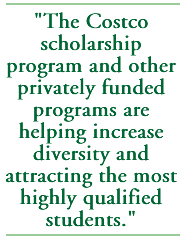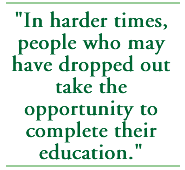 THE UNIVERSITY OF WASHINGTON ALUMNI MAGAZINE
THE UNIVERSITY OF WASHINGTON ALUMNI MAGAZINE
 THE UNIVERSITY OF WASHINGTON ALUMNI MAGAZINE
THE UNIVERSITY OF WASHINGTON ALUMNI MAGAZINE
|
Briefings2001 Freshman Enrollment Hits Record; Getting into UW May Be Harder in FutureThe largest freshman class in the history of the University of Washington arrived at the Seattle campus Oct. 1, with 5,382 members of the Class of 2005 filling residence halls and classrooms to capacity. In total, the Seattle campus saw 37,412 students, a 3.5 percent increase over last year and only 135 students short of its all-time enrollment record-37,547 set in 1979. The undergraduate enrollment is 26,860 and the graduate/professional total is 10,552. The UW reported that 26.2 percent are students of color.  Both newer UW campuses also reached new enrollment records, with 1,998 in Tacoma and 1,679 in Bothell. These campuses enroll juniors, seniors and graduate-level students, and specialize in serving older, "placebound" adults. Across the nation, many universities and colleges are experiencing record enrollments, says UW Director of Admissions W.W. "Tim" Washburn. Based on past enrollment patterns, the UW expected 5,100 new freshmen. "Even though we had almost 300 extra, we were able to take care of the added numbers," Washburn says. Many double rooms in residence halls were converted to triples, and the UW added more entry-level courses in key subjects such as math and chemistry. Even with the extra freshmen, the academic standards for admission remain high. The Class of 2005 had an average high school GPA of 3.63 and an average SAT score of 1159-virtually matching the standards set by a smaller freshman class last year. The 2001 freshman class also had some encouraging numbers for underrepresented ethnic groups, but the UW "still has a way to go," says Washburn. With the passage of Initiative 200 in 1998, the UW could no longer use ethnic background as a factor in the admission process, and numbers dropped the following year [see "The Road Ahead," March 1999]. Today the numbers are getting close to 1998 levels, he explains. For entering freshmen, this year saw 120 African Americans compared to 124 in 1998, 52 Native Americans compared to 53 in 1998, 193 Latino/Hispanic Americans compared to 196 in 1998, and 31 Hawaiian/Pacific Islanders compared to 38 in 1998.  He added that while the raw numbers are close to 1998, the proportion of underrepresented ethnic groups still lags, due to the overall increase in the size of the freshman class. The academic strength of the freshman class, and in particular these ethnic groups, is extremely high, Washburn adds. "You will see even stronger graduation and retention rates. We will see tremendous student leaders and mentors coming from this group." He credits the UW's outreach and recruitment efforts for the rising numbers and quality of these students. "The Costco scholarship program and other privately funded programs are helping increase diversity and attracting the most highly qualified students," he says. The overall boom in college students is a combination of factors. Washburn says the population bulge in 18- to 24-year-olds is one factor, but there are others. The economy has a large effect on both freshmen and returning students. "I've had interviews with students in private colleges who are transferring to the UW because they can no longer afford the tuition," he says. "In harder times, people who may have dropped out take the opportunity to complete their education," he adds. This fall the UW saw a large increase in these returning students. He warned that in economic downturns, the state is "less able to fund the additional enrollments."  Even before the economy softened, the state had only funded a portion of the enrollment increases the UW said were necessary to keep access open [see "State Funding Falls Short," September 2001]. As a result of state enrollment limits and the large number of freshmen this year, it may be more difficult to get into the UW next fall. Washburn says the UW will continue to attract top students from across the nation and around the world. He says there are four major factors in making the UW their first choice. Seattle is a world-class city that is attractive to young people, he explains. The UW offers a comprehensive curriculum spanning everything from engineering to pre-med to drama to political science. "Students unsure of their majors know that we have a large menu to choose from," he says. "And we have outstanding nationally ranked programs across that curriculum." In addition, a "real draw'' is the UW's emphasis on service learning and undergraduate research, he says.
|